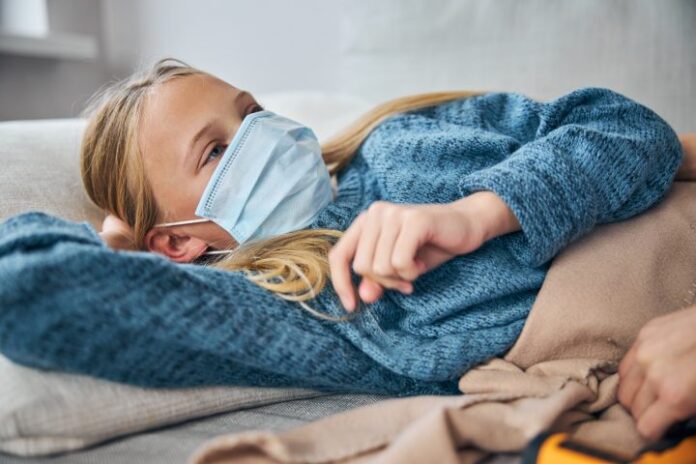From being an active, sports-loving 10-year-old kid to missing gym class, COVID-19 has turned Matthew Kirpatrick’s life upside down.
The Edmonton fifth grader tested positive for COVID-19 in September last year. Initially he was mildly ill, but weeks after, his family was shaken and struggling for answers.
“We went for a family bike ride and that’s when we knew something was terribly wrong,” said Nancy Kirkpatrick, Matthew’s mother.
“He stopped midway through. He couldn’t catch his breath, and he complained of this horrible chest pain.”
They booked an appointment with a family physician, but before they could get in, Matthew collapsed in an alleyway while walking home from school one day and broke his front tooth.
“There was blood everywhere, and I was bleeding all the way home. It was just dripping down my face. It was horrifying,” the 10-year-old told Global News.
Matthew Kirkpatrick pictured here before COVID-19 infection.
Photo supplied by Nancy Kirkpatrick
Since then, Matthew has had two more severe blackouts at school.
On one occasion, he fell out of his desk and dropped to the floor. And the second time in November, his teacher had to yell and physically rouse him after he passed out in class in a “very awkward position”, his mother said.
Matthew’s COVID-19 infection caused tachycardia, the cardiologist who diagnosed the problem told the family. It’s a condition where the heart rate races to more than 100 beats per minute.
Matthew Kirkpatrick pictured here in the cardiologist’s waiting room before his stress test.
Photo supplied
More than two years into the pandemic, experts are still trying to determine the impact of long COVID — when symptoms last at least a month after a person is diagnosed with COVID-19 — and learn how to help the sufferers. Those people are often referred to as COVID long haulers.
A new study published Sunday ahead of peer review, suggests that one in four children and adolescents will suffer some form of post-COVID-19 symptoms. Mood swings, fatigue, and sleep disorders are the most common.
Cardiorespiratory symptoms, such as chest pain and tightness, variations in the heart rate and palpitations are less common but are reported in the study that analyzed over 80,000 people aged between 0 and 18 years.
New research sheds light on ‘long COVID’ – Jan 29, 2022
Dr. Scott Hadland, chief of adolescent medicine at the Massachusetts General Hospital in Boston, said it is worrying to see mood symptoms, sleep disturbances and fatigue linger for at least a month after COVID-19 infection.
Trending Stories
British businessman killed execution-style near Mexico’s Playa del Carmen
Bob Saget death: Final report details last moments of actor’s life
While children are less likely to suffer severe COVID-19 illness, this latest piece of research is a reflection that “COVID is not without consequences for kids”, said Hadland.
The mental toll of living through the pandemic is a factor for many teens, but some of the symptoms can be attributed to the virus too, he added.
However, Dr. Fatima Kakkar, a pediatric infectious disease specialist at the CHU Sainte-Justine Hospital in Montreal, has doubts about the accuracy of the study and the methods used, saying it doesn’t reflect what is being observed in the clinical day-to-day reality.
Since the start of the pandemic, Kakkar said her children’s hospital has only had 20 referrals for long COVID out of the thousands of kids who have had the infection. She said teenage girls were more susceptible to post-COVID symptoms than younger kids.
“We’re not seeing persistent symptoms that cause dysfunction in the vast majority of children,” she said.
In Canada, and elsewhere, many children remain unvaccinated, as COVID-19 shots have so far not been approved for those under the age of five.
As restrictions are lifted across the country, Kakkar said families with young children should proceed with caution as they return to some form of normalcy.
“I think it’s reasonable for them [young children] to go about their activities, but their entourage has to be really, really well-protected if they aren’t already,” she said.
British mom Claire Hastie has twin boys, William and James, who have been struggling with long COVID for the past two years. The teenage boys from Durham caught the infection three times.
Their symptoms have ranged from severe headaches, chest pain, body aches, diarrhea, feet blisters caused by a condition called COVID toes, nosebleeds and seizure-like episodes.
William and James, 13, pictured here with their mother.
Photo supplied by Claire Hastie
The physical struggles have forced the 13-year-olds to miss out on school and a social life.
“It’s been really hard for them because they’ve been in and out so much,” their mother said.
“So everyone’s had a very disrupted education, but … [for] the children with long COVID, it’s been even more because it’s all of the relapses and symptoms have really made it difficult.”
Hastie, who is also suffering from long COVID, worries about the long-term health effects since there is limited data and studies on long COVID.
“It’s heartbreaking and we have no idea what repeated infection is doing to our children’s growing bodies,” she said.
How to prepare kids for a post-pandemic life – Feb 26, 2022
Those concerns are shared by the Kirkpatricks.
While Matthew’s health has improved with less complaints of dizziness and chest pain, the Edmonton family is not taking any chances.
“Our life is now going to be just a bit different. I think we’re going to be pretty cautious about everything,” said Nancy Kirkpatrick.
© 2022 Global News, a division of Corus Entertainment Inc.



